|
Back to Green Cove Springs
and back to work!
12th - 25th March 2007
|
|
The friendly staff at Green Cove Springs leapt
into action to help us out and by our first afternoon back in town, Anju was
again dredging her way up the channel to the travel lift, ready to be hauled
out. In no time she was up in the slings, lightly washed
(we didn't want to pressure wash off all the expensive ablative anti-fouling
paint we'd applied only a few weeks earlier!) and on her way to a spot in
the work yard. Then we heard a loud bang and instinctively
covered our eyes, not wanting to see our beloved boat crashing to the floor
if the travel lift had broken. As it happened the travel
lift had broken but Anju was still safely suspended and
stranded. A bolt on the steering mechanism of the lift had
sheared off, leaving the lift diagonally across the road in the boat yard
and unable to move. For a while we feared we may be
spending the night in the laundry room but Paul quickly got the problem
fixed and settled Anju down safely in her spot in the work yard.
|
|
As soon as the hull dried out, the cause of our
problems was obvious. A small hole could be seen in the
hull, below the waterline, where the steel seemed to have rusted from the
inside out, as we'd feared. Whereas the rest of the hull
was now dry, water was still seeping from the hole. Now
just how we'd made it all the way from Lake Worth to Green Cove Springs with
a hole in the hull below the waterline, without even having any more water
in the bilges could only be described as a minor miracle. We were just lucky
that we'd had that opportunity to sail and heel over and the extra pressure
of water on the heeled hull had forced water through the hole, bringing it
to our attention before we set off across the Gulf Stream!
|
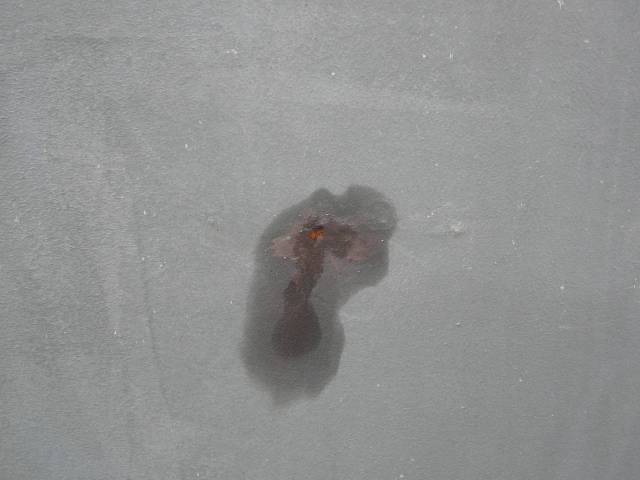
The Hole
|
|
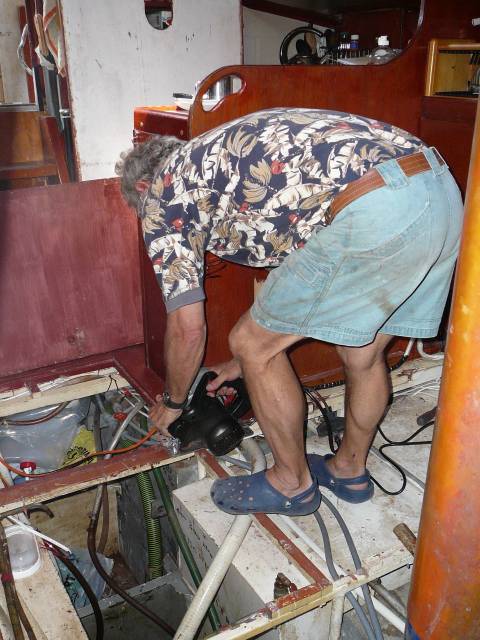
Dismantling half to boat to
find the small hole
|
Although the hole was pretty small, of course
accessing the area in which the hole was located involved dismantling half
of the boat. Up came the port side sofa and storage lockers
beneath, so the floor could come up. Then we found that the
floor was supported with long pieces of wood, some of which ran the entire
length of the cabin, so out came the circular saw. Finally we'd
removed all the wooden floor supports, the tie-downs holding the tanks in
place and all the pipe work connected to the two tanks.
The remaining diesel in the fuel tank was drained and poured into the
starboard side tanks and we were ready to try to lift the tanks out of the
holes which had been their homes for 23 years.
|
|
Harry, our welder, had kindly lent us his
"come-along", a lifting device which enabled us to raise each tank
a fraction of an inch at a time. On discovering how wonderful
this device was, we quickly made a trip to Home Depot to invest thirty
dollars in one of our very own.
We began by lifting a water tank, one which
we'd never used in our ten years aboard. We'd always wanted to
remove the two obsolete water tanks we had aboard and finally we had the
opportunity. Once the tank was finally above the floor,
Phil broke in his new reciprocating saw and we took turns in cutting the
steel tank into two pieces small enough to pass through the companionway
door for removal from the boat.
|
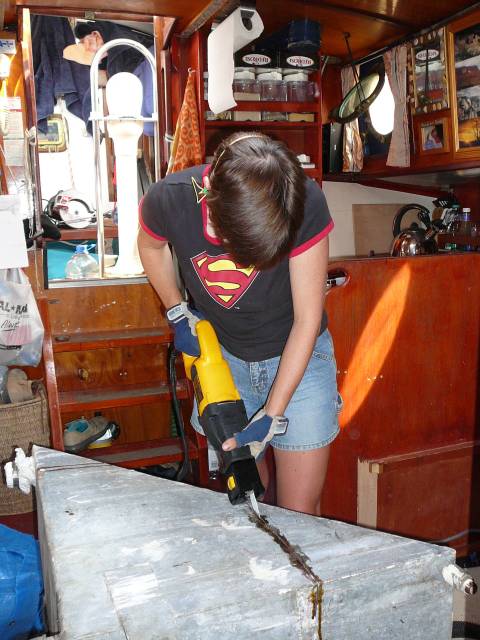
Cutting up the obsolete
water tank
|
|
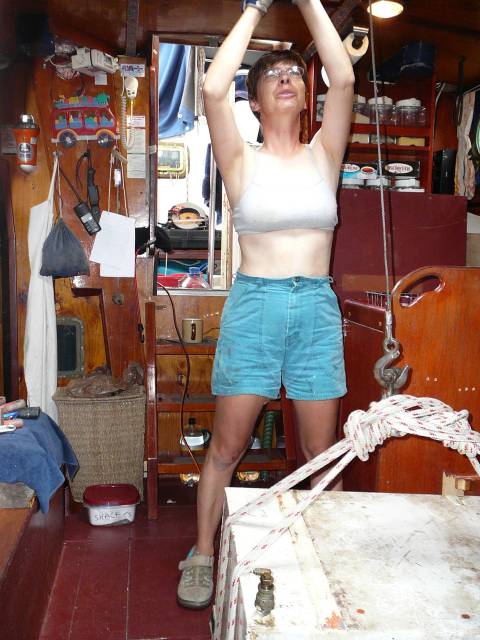
Lifting the diesel tank
with the "come-along"
|
Next we tackled the diesel tank, lifting it
inch-by-inch out of its hole and into the cabin. By now we
were living in chaos as we'd had to move all the contents of the storage
lockers on the port side below and behind the sofa and the dining table, to
make room for a huge diesel tank in the centre of the
saloon. We were very happy when our pal Rob came by the
boat to tell us that he'd heard that one of the storage sheds in the marina
had become available and we should quickly go to the office and rent
it. Of course this meant that huge amounts of heavy and
cumbersome items from our boat had to be carried down the ladder and over to
the shed but once we'd begun to make a little more space aboard, it became
much easier to work.
|
|
Harry came by to inspect our progress and help
us decide what would be best remedy. After studying the hole, the rust
around it and the condition of the stringers which run along the boat, we
decided it would be best to cut out all the corroded steel and weld in a
piece of new steel and new stringers in its place. It
seemed that water had probably been leaking from our shower, running down
the stringers of the boat and just sitting on the hull, unable to drain down
to the bilges. We were definitely going to make sure that no
water would escape from the bathroom in future and if by any chance it
should, that there would be drain holes in the new stringers to allow any
water to drain down to the bilges. It was arranged that Harry would
come by in a few days to start work on the repair.
|
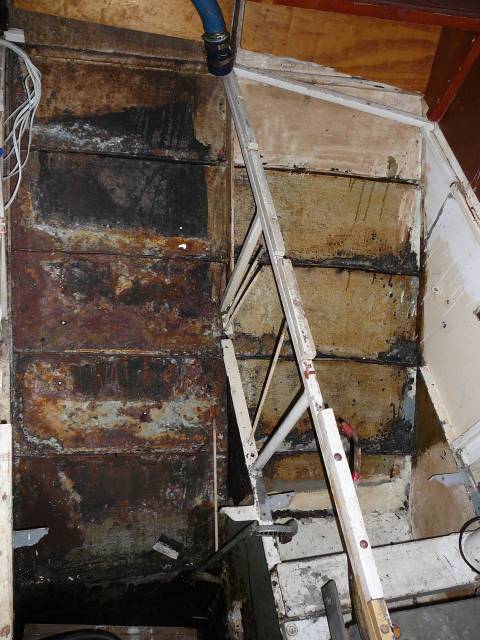
Hull beneath the tanks,
lots of rust below the diesel tank.
|
|
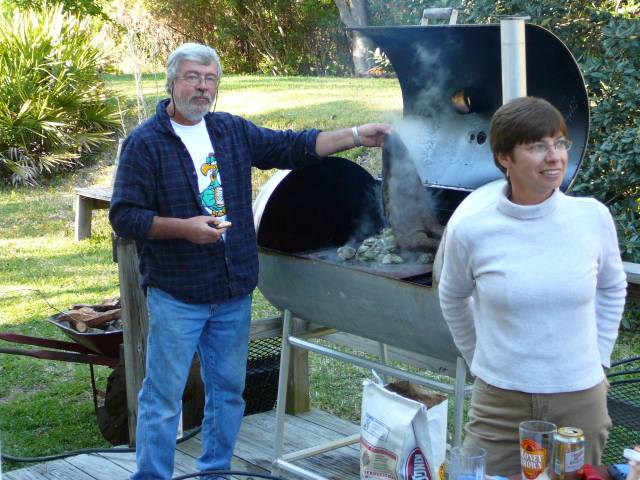
Harry demonstrating oyster
steaming on his home-made smoker, welded from a truck fuel tank.
|
Around this time two things happened to cheer us
up. Firstly Harry invited us to his home to enjoy some delicious
steamed oysters and shrimps and to help celebrate the birthday of his wife
Jane, along with some of their friends.
In another amazing act of generosity, our
wonderful friends Chris and Vivian, in North Carolina, offered us the use of
their car. We rented a car for a couple of days and took a
flying visit to Little Switzerland to collect their car and spent a day
enjoying their company. Having access to a vehicle would make
life a lot easier while we were working on the boat. Our
trip back to Florida was quite an adventure as we drove in convoy, using our
walkie-talkies to keep in contact.
|
|
Whilst we were waiting for Harry to start
work, we decided to rip apart the bathroom to check for rust beneath
that area. In any case, a major overhaul was required to ensure
we wouldn't have any water leaks in future. The heads and shower
pan were removed and all the surrounding wooden cabinetry was removed and
carefully labeled, in the hope that we'd remember how to fit it all back
together later.
As we delved into the depths below the
bathroom we removed the grey water tank which is the sump for the shower
water and then we came to the black water holding tank, used to collect the
contents of the toilet on each flush, in areas where overboard discharge was
not allowed. We expected the tank to be empty but were
horrified to find it full to the extent where it was almost bursting at the
seams, it seemed we'd had a plumbing malfunction. Despite the horrors
of having to manually emptying the holding tank of its unmentionable
contents and cart if off to the dump station, we were lucky that the tank
hadn't burst its seams or blown a hose, filling the boat with its
contents. Now we felt we truly understood the meaning of that
bumper sticker "S**t happens!"
Now Anju was ready to spend some quality time
with her favourite welder.......
|





